As you sit down to write your emails, one of many questions that come to your mind might be “How should I format my emails?” or “Is this the correct format for this email?”
There is no single way to format an email perfectly. There are guidelines that you can follow, but in the end, it all comes down to your goals, industry, and your recipients.
But, you have to start somewhere.
This guide will help you do just that by navigating through different email formats with examples and best practices you can follow.
Table of contents
- What is an email format?
- How to format an email?
- Email format examples
- Email format best practices
- Takeaways
What is an email format?
Email format refers to the structure of your entire email, beginning from the subject line and ending at the email signature. The format of an email will vary depending upon the nature of the email.
For instance, a formal email format will differ from an informal one.
How to format an email?
Let’s discuss five important elements of formatting an email in detail:
1. Write a clear subject line
The subject line is the first thing that the recipient will see. So, it must be clear and state the intent behind sending a particular email. Here are some ways to write a compelling subject line:
Keep it clear, concise, and within the standard character limit.
Keep the recipient and intent of your email in mind while writing email subject lines.
2. Write greetings based on the recipient
Always begin your email with a greeting or salutation. It sets the tone of your email. Of course, salutation and greeting will differ depending on the email you send and your relationship with the recipient.
For instance, if you are sending a professional email and don’t know the recipient that well, it is good to write something like:
Hey (Name)
Hello (Name)
Greetings
Dear (Name)
3. Keep email body concise and focused
The email body covers why you are writing the email, builds up a back story, and incites interest and engagements among the recipients. You don’t have to be super descriptive and write a long email with unnecessary and irrelevant information, and neither do you have to sum up the entire email in one line - balance is the key.
4. Give a descriptive name to the attachments
You might or might not send attachments in your email, and that’s okay. But, if you do send them, a good practice is to name them properly.
For instance, if you send your resume, instead of naming it as 1.pdf, you should name it as (Your Name)Resume.pdf. It will create a great impression, and the recipient can easily figure out what the pdf is about.
5. Have a clear and visible email CTA
Every email must have a clear purpose, and your email call to action must reflect that.
For example, in a marketing email, an email CTA may look like a button saying “Learn more,” “Click to read the blog posts,” etc. But, such buttons are not likely to be there while sending professional emails or emails to your colleagues.
Despite that, it doesn’t mean that you don’t include a call to action. Without it, the recipient won’t know what you want them to do. For instance,
So, always include a clear call to action in your email and make it visible so that the recipient knows what action to take.
6. Always close emails with a proper salutation
Signing off is the last part of your email. This is the part where you include your name or your organization’s name. In fact, you can have fun and be creative while writing your email signature.
For instance, Mailmodo adds a casual phrase and their name in one of the emails.
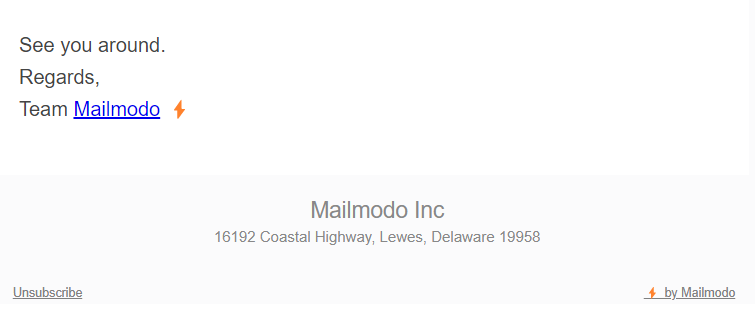
Email format examples
Let’s look at some examples of different types of email formats:
● Welcome email format
Welcome emails are crucial to connect with your subscribers and nurture them. Sending a properly formatted welcome email can help increase users’ engagements while informing them about your brand.
Here are tips to perfectly format your welcome emails to get higher engagements and build stronger connections:
Keep your subject line concise and distinguishable from other emails. For example, you can write something like, Welcome to the family or You just signed up.
Start your email with a proper greeting. It means you should welcome the subscribers, and if you can personalize that greeting, it will be like the cherry on top.
Email body:
Start your email by thanking users for signing up and giving their valuable time to you.
Introduce your brand and let users know what they signed up for. The kind of emails they can expect, etc.
Since welcome email is a part of the nurturing cycle, the right call to action must be there. You should tell users what action they should take next. For instance, you can add links to your most relevant posts they should read.
End your email with the right salutation. It should reflect professionalism and friendliness.
The below welcome email template begins with a clear headline and then moves on to thank users and brief them on what they can expect in future emails. Besides, this email aims to nurture and inform leads, so there is more than one CTA.
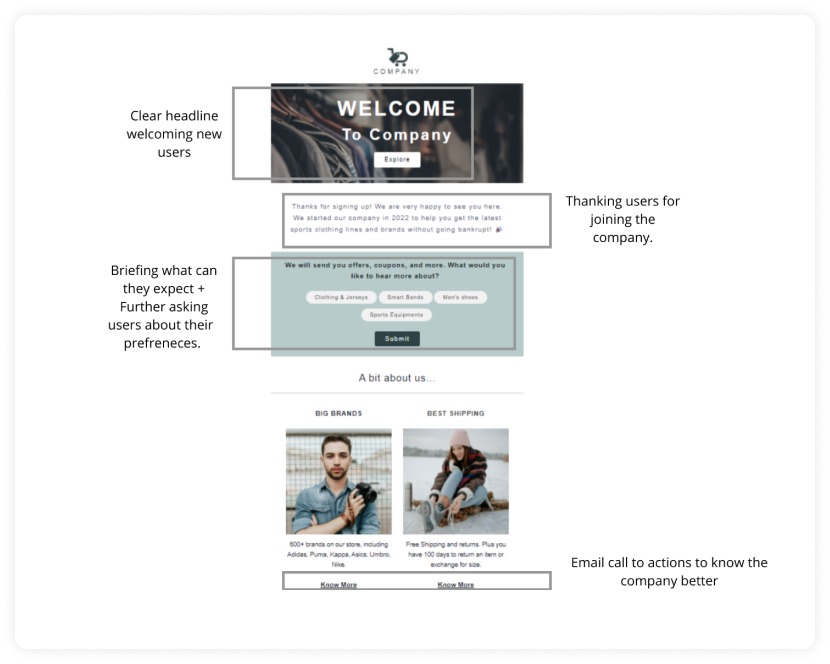
● Promotional email format
Promotional emails are solely sent to promote a product or services, upcoming events, seasonal sales, etc. Their purpose? To drive sales. Simple.
But writing them properly is crucial. Here are ways to do that:
Make your subject line enticing. For example, you can include words like Update, Sales, etc., to let users know what the email is about.
Begin with a proper greeting. You can also personalize using the users’ first names to connect better.
Add a compelling headline that highlights your offer. Then you can talk about information to let users know how they can avail the offer. Along with that, you can add visual elements like GIFs, Images, to make it more engaging.
Always end your promotional emails with a compelling and clear call to action and make email CTA creative rather than generic.
Sign off by adding your brand name, social media links, and relevant information to the users.
Here is a breakdown of the promotional email format by Mailmodo.
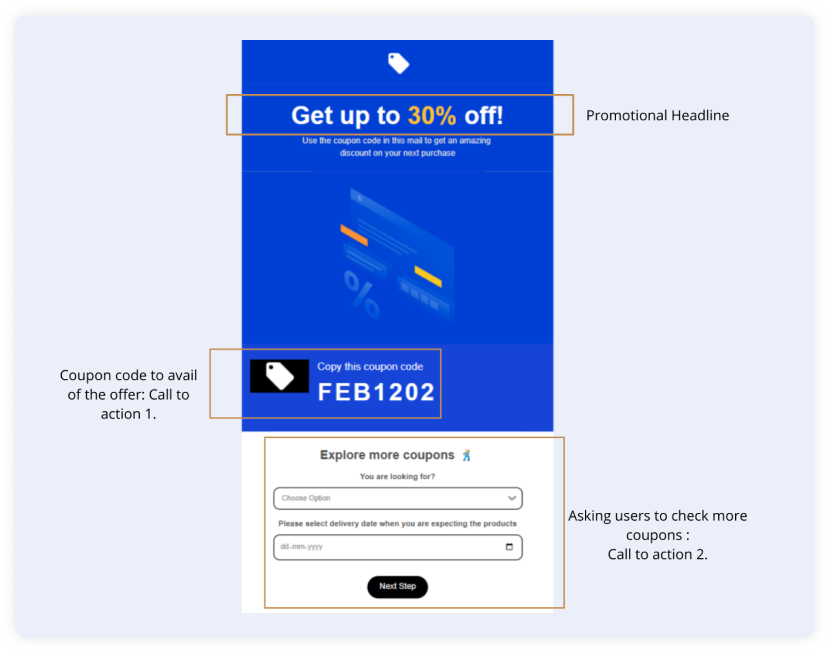
● Transactional email format
Transactional emails format is more formal as they are sent to update and inform users about their transactions.
For example, it can be about order confirmation, shipping details, signup confirmation, event registration details, etc. Moreover, as these emails are sent to keep users aware, they don’t have a CTA.
So, these emails follow a standard format like
Greeting users usually with thanking them for their action.
Briefing them about their transaction, including the respective attachment (link, invoice, etc.), thanking them, and asking them to check their inbox for further updates.
Signing off with your brand’s name.
Here is a transactional email format beginning with greetings in the headline and then briefing users about their transactions. The email also asks users about their feedback, the email CTA.

Read about - 7 Transactional Email Best Practices For Maximum Conversions
● Cold email format
Sending a cold email might be the most difficult email to send. Reaching out to a stranger or someone you admire can seem intimidating, but a properly formatted cold email can do wonders.
So let’s look at how to do that:
Since the recipient might be getting thousands of cold emails, writing a catchy and intriguing subject line will help you stand out from the crowd.
As you don’t know the recipient, it is good to stick to professional greetings like Hi/Hello, Dear(name).
Before you write the cold email body, we recommend you research the recipient and add relevant information to understand what you know about them. Some additional things to keep in mind:
Don’t start pitching yourself in the beginning.
Talk about how you can help them solve their problem or provide value.
Add testimonials, references to build authority and trust. If you don’t have any, then leave this part.
Even though you probably include your offer in the email body itself, it is best to include another call to action towards the ending to make it clearer to the recipient.
Again, it is best to stick to the professional email sign-off like Regards, (Your name). But, you can take your time and play with different email closings. For example, you can express gratitude for the recipient’s time.
● Newsletter format
The newsletter comes in all shapes and sizes as informational, includes multiple call-to-action, and has different purposes.
For instance, Marketing brew, Search Engine Journal sends a weekly newsletter summarizing industry news with links to different blog posts, a list of upcoming events, new job postings, and much more.
On the other hand, some newsletters entirely contain the repurposed content from the original post and give you a preview of the original post.
So, there is not a pre-defined format while writing a newsletter. Whatever resonates with your audience, and helps you achieve our goals will be the perfect one.
Here is a breakdown of the bi-weekly newsletter format that Mailmodo sends:
- First comes the headline and greeting, which we keep generic. Then we add a little email and 1st CTA to ask users’ views via a survey that we are currently working on.
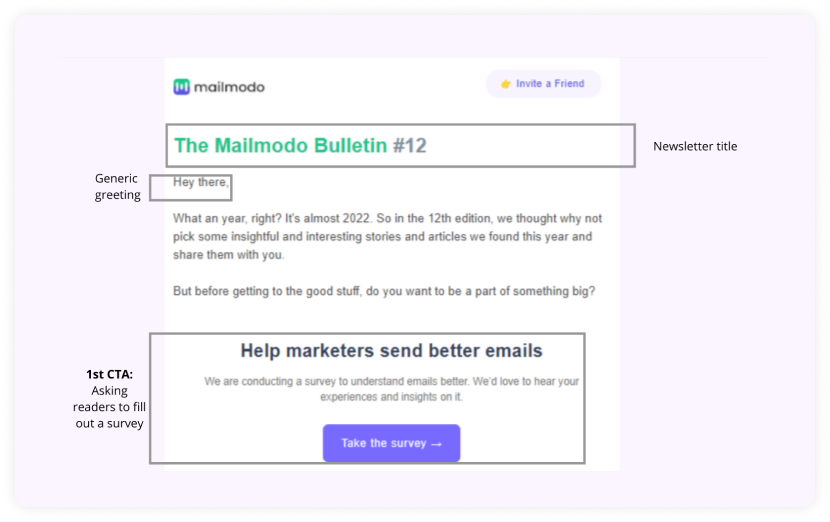
Then we include a list of the best and relevant articles to inform readers what is trending in the industry.
Then comes the 2nd CTA, where we add a link to our latest growth chat session. In addition, to dust off information load, a GIF is added.
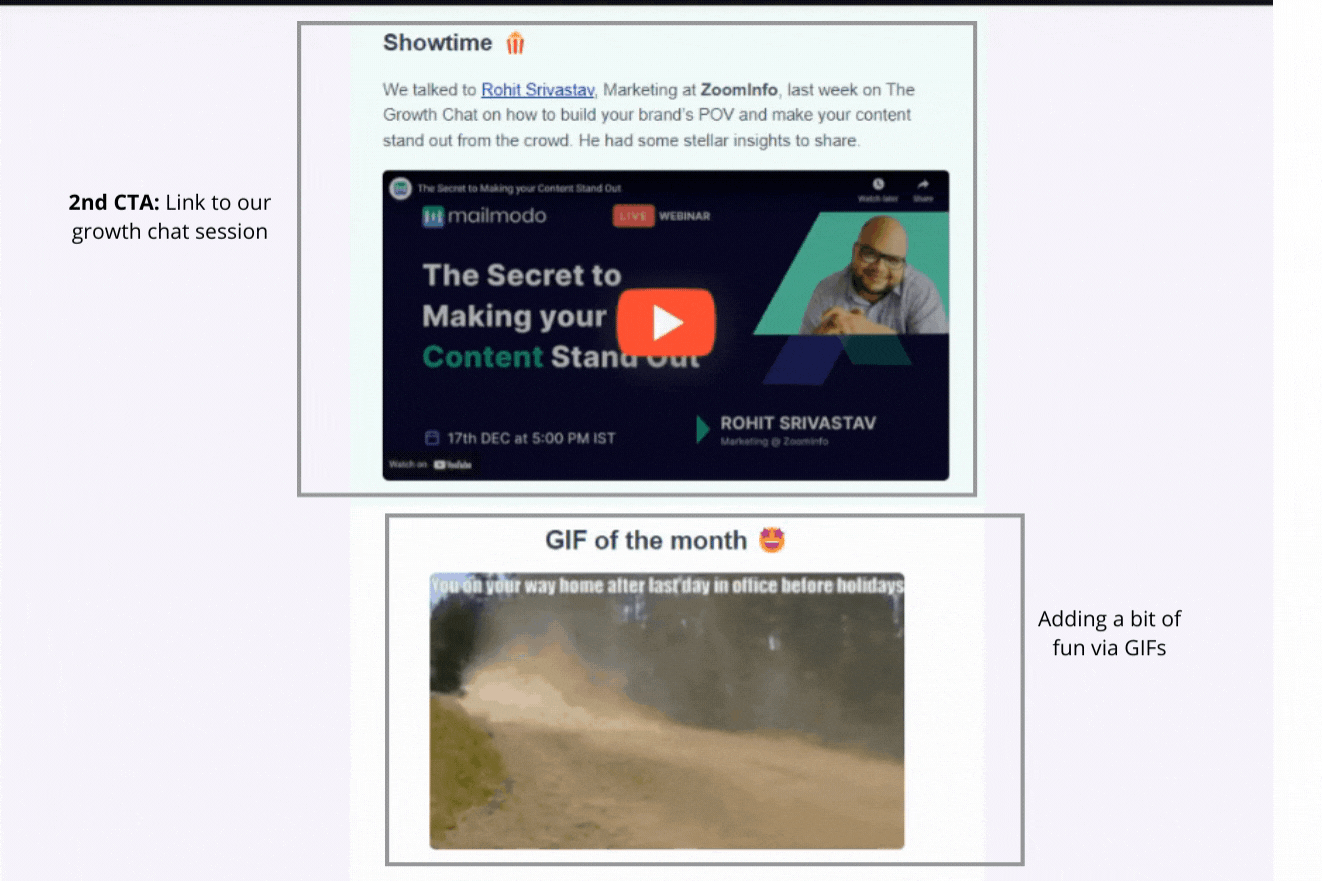
Towards the newsletter end, we include a 3rd CTA. It changes in every edition.
Then, we sign off and, in the end, include a feedback form to get insights into our edition.
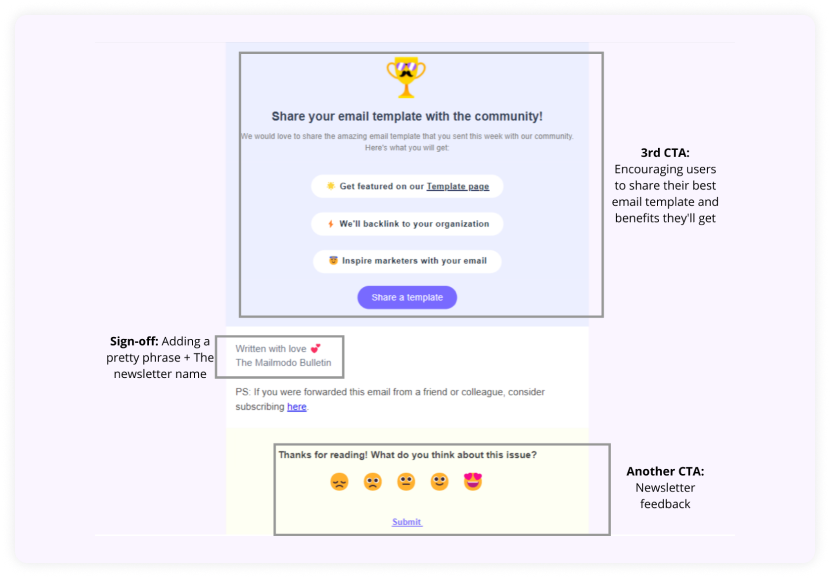
If you want to know more about newsletters, read our guide - 12 Newsletter Ideas To Try Out In 2022.
● Follow-up email format
Follow-up email formats must include a catch-up on earlier emails sent to the recipient to sound relevant and make sense to them.
For instance, if a user checked your product pages but didn’t sign up, you can send them a follow-up email that goes something like -“Hey, we saw that you checked out our products. Feeling stuck somewhere? We can help!”
The follow-up email below begins with thanking users and greeting users with their names. After that comes the email body and the email CTA - the feedback form.
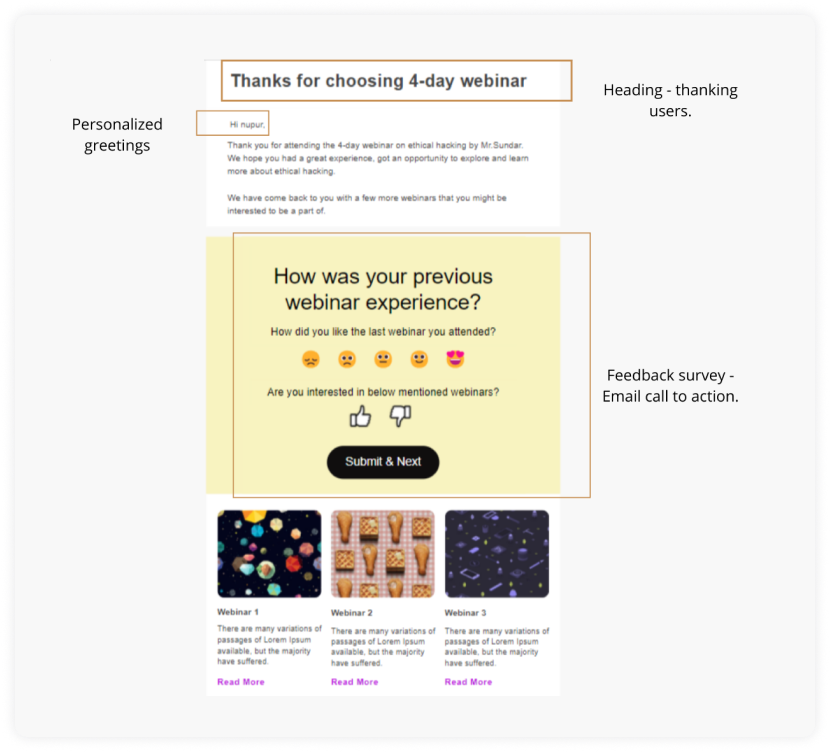
Email format best practices
While you are deciding on how to format your email marketing campaigns, ensure that you follow these best practices to get the desired results:
Use tone and style that will resonate most with the recipient.
Keep your target recipient and the intent of your emails at the core while writing the email.
Always preview your emails for typos and other errors before sending them.
Personalize your email wherever you can - subject line, greetings, email copy, email call to action, etc.
Make your email responsive for different devices.
A/B tests different email formats to decide which works best and generates desired results.
Takeaways
Formatting an email follows the same structure as writing a letter - you acknowledge the reader, put your thoughts forward, and end with a clear call to action. When you format an email properly, you gain readers’ attention, encourage them to take action, and let them know how to connect with you.
But, you don’t have to always abide by the standard format. If you think you can make your email more appealing and engaging to the reader by trying out a different approach, then why not?
However, if you are looking for a tried-and-tested, industry-approved format, then you can always take a look at the tips compiled by us for your benefit.


